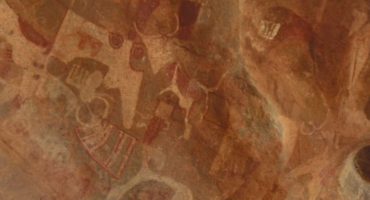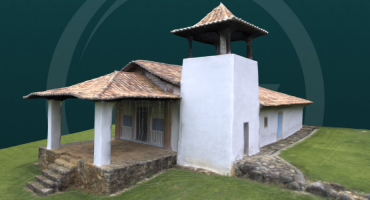Hop on board as we continue our journey Around the World in 80 Models! We began our itinerary at Sketchfab headquarters in New York and are working our way through Europe, Africa, Asia, Oceania, South America, and North America. To catch up on past destinations, check out the rest of the Around the World in 80 Models series.
This week we travel to Scotland with two archaeologists. Hugo Anderson-Whymark will tell us about a Neolithic house at Skara Brae, and Claire Herbert will tell us about a carved Pictish stone from Kintore.
Skara Brae, Scotland: House 2
http://sketchfab.com/models/e12c4389a6154bf5a72b74c34a1823b8
Hello, my name is Hugo Anderson-Whymark and I’m an archaeologist based in Orkney, Scotland. I’ve spent the last 20 years researching prehistoric stone tools and excavating archaeology from Stonehenge to Syria. Every summer I dig at the Ness of Brodgar, a massive complex of Neolithic buildings, which can be viewed on Google StreetView, and a few years ago I started experimenting with photogrammetry to record the excavations. The archaeology was so amazing I wanted to find a way of rapidly documenting the site and sharing it (here’s one of my favorite models). Today, as a researcher at University of York, I use photogrammetry to make 3d models of prehistoric stone tools, prehistoric monuments and archaeological excavations.
This scan of House 2 at Skara Brae was made when I visited the site as a tourist. All of the photos used in this model were taken from the public viewing areas in less than 10 minutes, while my wife and daughter explored the other houses. I used a 20mp Canon 70D mounted with a Canon EFS 10-18mm lens, set to 12mm, to capture the 63 photos used in this model. The images were processed using Agisoft Photoscan Standard Edition. The photos were all taken from ground level, but if I was doing this model again (properly!) I would have taken more images and mounted the camera on a 4m pole to obtain a series of vertical images. This would greatly improve the resolution of the model and photographic texture.
Located in the Heart of Neolithic Orkney World Heritage Site, Skara Brae is an iconic late Neolithic (c.3200-2300 BC) settlement with houses that survive to roof height and furniture constructed from fine Orcadian flagstone. The presence of stone hearths, bed-boxes, dressers and doorways makes these buildings feel as if they were abandoned yesterday rather than 5000 years ago, providing a unique connection with our distant ancestors. Skara Brae is one of my favourite prehistoric sites and one you must visit on a trip to Orkney.
To see more of Hugo’s models here on Sketchfab, check out his profile.
Kintore, Scotland: Kintore Stone
http://sketchfab.com/models/5ea891c9248a4293b764da9b1f0ec2d9
My name is Claire Herbert, and I’m a Regional Archaeologist for Aberdeenshire, Angus, Moray and Aberdeen City Council areas. I’m based in Moray, North East Scotland, and work at the Aberdeenshire Council HQ in Aberdeen. I became interested in 3D modeling in 2014/2015, and the possibilities it presented for recording and promoting cultural heritage assets. I attended a training course on Photogrammetry at the Centre of Archaeology, Staffordshire University, in September 2015 – a great course that introduced the basic theory of the subject as well as providing practical experience. After that, I was hooked!
Generally, I carry out the recording and create the photogrammetry models in my free time, on my own, but the subject matter (archaeological sites) and the reason for creating the models relates to my professional life. I see photogrammetry models as a fantastic way not only to record and monitor archaeological sites, but, more importantly, to make them accessible to everyone so that no matter where you are in the world or what your physical abilities are you can “climb up the hill to visit the stone circle”!
I record sites using a standard digital SLR camera (Canon EOS 700D with 18-55mm lens), process the images using Photoshop, and create the photogrammetry models using Autodesk 123D Catch and Autodesk Memento.
This particular model is the first one I created after going on the Centre for Archaeology (Staffordshire University) one-day training course, and I was so excited (and a little bit surprised) to see the end result! I chose this subject matter as I thought it would lend itself well to the medium. Also, having designed and produced a heritage trail leaflet celebrating 10 of the best Pictish Stones in Aberdeenshire in early 2015, I was keen to see how (and if) the subject would work, with the intention of creating a series of models of the Pictish Stones featured on the trail. Called the Pictish Stone Trail, the leaflet is designed to showcase 10 of the best and most easily accessible Pictish Stones which you can visit in Aberdeenshire. For each stone it includes a summary description of the stone’s history and decoration, along with driving and walking directions for how to get to the stone.
There were some difficulties in photographing the stone as it sits quite close to the church wall, so it was a bit of a physical challenge to get the whole stone in the photo with the right overlap ratio – one of those days when it’s good that no one is around to see how silly you look contorting to try to take photographs!
This is a model of the Pictish carved stone in Kintore Churchyard. Kintore is a small village in Aberdeenshire, c.12 miles Northwest of Aberdeen. The Kintore Stone is a Class I Pictish stone. This is a classification dating back to the early 1900s, which defines a Class I stone as a stone or boulder which has not been shaped and which has only Pictish symbols carved on it, no crosses. It is also thought to be the earliest class of the Pictish Stones, dating from around the 6th – 8th Centuries AD. Class II stones, dating from around the 8th – 9th centuries AD, are usually shaped stones and are decorated with both Pictish symbols, cross motifs and other Christian symbols. Class III stones, also dating from the 8th – 9th Centuries AD, are decorated with with mainly Christian motifs, and are often in the form of free-standing crosses.
The Kintore Stone is decorated with carvings of a fish (possibly a salmon) and cauldron symbol on one face, and a crescent & V-rod and Pictish “beast” symbol on the opposite face; it also has some later graffiti carved into it. The exact meaning of Pictish symbols and the purpose of these carved stones is not known, but it is possible that the stones acted as a form of commemoration stone or a land or territory marker with the different symbols representing the names of individuals or groups. Although each stone is different, some symbols are more common than others – the crescent and V-rod, for example, is one of the most common symbols seen on Pictish stones.
Aberdeenshire is considered to be the heartland of the Pictish community, and around 20% of Scotland’s Pictish Stones can be found in the region. The Pictish Period as defined as c.300 AD to 900 AD, but the origins of the Picts can be seen in the tribal society of the Iron Age. They lived in Scotland, North of the Forth and Clyde rivers, with a particularly strong presence in what is now Aberdeenshire, and their society was hierarchical, with a warrior elite and a lower farming class. The name Pict or Picti, meaning “Painted People” was bestowed on them by Roman writers, and much of what is known of the Picts is derived from historical writers. The Picts left no written records of their own, and the beautifully carved stones which they left behind offer a tangible link to their fascinating culture.
Link to the pdf of the Aberdeenshire Pictish Stone Trail and the stone’s record entry in the Aberdeenshire Sites & Monuments Record.
To see more of Claire’s models here on Sketchfab, check out her profile.







